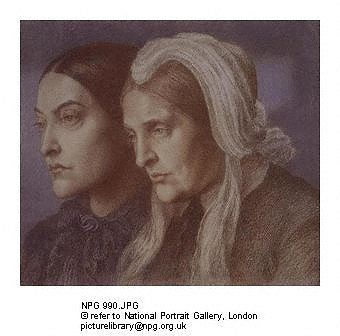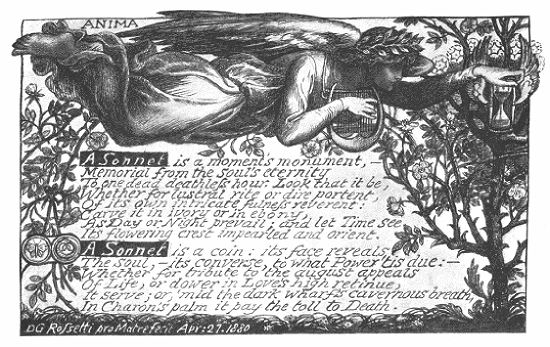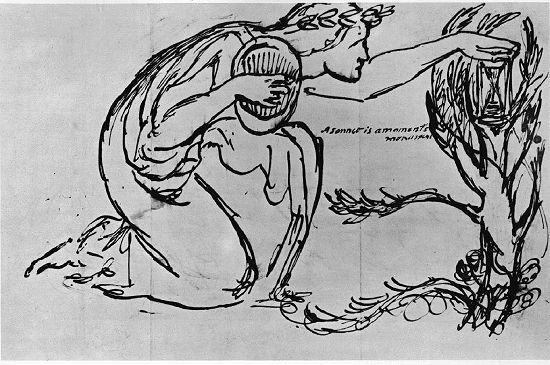The Moment and Monument of Two Rossetti Sonnets
Lorraine Janzen Kooistra
Ryerson University, Department of English
977
|
On April 27, 1880, Frances Rossetti turned eighty. In honour of her birthday, the poet Christina Rossetti (1830-1894) gave her mother a copy of David Main's Treasury of English Sonnets, embellished with a hand-written sonnet@A sonnet is a fourteen-line poem written in iambic pentameter--that is, in lines of ten syllables each, in which the dominant rhythm is patterned on five weak/strong stresses. A sonnet's organization determines its "argument." The Shakespearean or English sonnet works out its tensions, statements, counter-statements, and resolutions, over 3 quatrains and a couplet (abab cdcd efef gg). A Petrarchan or Italian sonnet develops its arguments in two parts: an octave of two quatrains (abbaabba) and a sestet (the rhyme scheme in these six lines varies, but cdcdcd is typical). Christina and Dante Gabriel Rossetti generally wrote variants of the Petrarchan or Italian sonnet. DGR's "A Sonnet is a moment's monument" varies the sestet to include a couplet: cdcdee. CGR's "Sonnets are full of love" varies the octave organization so that the rhymes end abbababa; the sestet uses the rhyme pattern of cdeecd. of her own and an illuminated sonnet by her painter-poet brother, Dante Gabriel Rossetti (1828-1882).@Christina Rossetti to William Rossetti, 20 June 1889, Letter 1665 in The Letters of Christina Rossetti: A Digital Edition.With their dual English/Italian heritage, the Rossetti siblings were proficient sonneteers themselves. In their youth, they had played a sonnet-writing game known as bouts-rimés, in which they would each write a sonnet based on 14 pre-set end words, usually using the Petrarchan rhyme structure of octave and sestet. The object of the game was to combine sense with speed, and they grew proficient enough to write sonnets in under ten minutes, some of them very good.@William Michael Rossetti, "Bouts-Rimés," Pall Mall Gazette vol. 16 in Rossetti Archive. Although William doesn't mention this in the article, sister Christina was as avid and adept a bouts-rimés sonneteer as her brothers. See also Jan Marsh, Christina Rossetti: A Literary Biography (London: Jonathan Cape, 1994), 84-5. In 1880, they were mature poets who had written many sonnets, including the intricate sonnet sequences they published in their poetry collections the following year: Christina's Monna Innominata in A Pageant and Other Poems (Macmillan 1881) and Dante Gabriel's House of Life in Ballads and Sonnets (Ellis 1881). This exhibit examines how the material context of the birthday gift of Main's Treasury of Sonnets, the holograph forms of both sonnets, and the combined visual/verbal expression of Dante Gabriel's illuminated manuscript, contribute to the meanings generated by "A sonnet is a moment's monument" and "Sonnets are full of love." |
|
In 1880, Dante Gabriel Rossetti was an acclaimed painter and poet then in the process of preparing his second collection of poems for publication. Since his establishment of the Pre-Raphaelite Brotherhood in 1848, Dante Gabriel had explored the complex relations between the visual and verbal arts and public (that is to say, institutionalized) and personal systems of signification. The illuminated sonnet he created for insertion in his mother's birthday gift represents a particular expression of these concerns. In the context of the Treasury presentation to his mother, "A Sonnet is a moment's monument" is an occasional poem, prepared specifically to celebrate an auspicious family event. Although Dante Gabriel Rossetti had drafted the sonnet in the months prior to Frances's birthday, the poem achieved its complete expression in the visual/verbal form he wrote and designed for insertion into the gift of Main's Treasury of Sonnets.
|
A Sonnet is a moment's monument, —
Memorial from the soul's eternity,
To one dead deathless hour. Look that it be,
Whether for lustral rite or dire portent,
Of its own intricate fulness reverent:
Carve it in ivory or in ebony,
As Day or Night prevail; and let Time see
Its flowering crest impearled and orient.
A Sonnet is a coin: its face reveals
The Soul,—its converse, to what Power 'tis due:—
Whether for tribute to the august appeals
Of Life, or dower in Love's high retinue,
It serve; or, 'mid the dark wharf's cavernous breath.
In Charon's palm it pay the toll to Death.
Memorial from the soul's eternity,
To one dead deathless hour. Look that it be,
Whether for lustral rite or dire portent,
Of its own intricate fulness reverent:
Carve it in ivory or in ebony,
As Day or Night prevail; and let Time see
Its flowering crest impearled and orient.
A Sonnet is a coin: its face reveals
The Soul,—its converse, to what Power 'tis due:—
Whether for tribute to the august appeals
Of Life, or dower in Love's high retinue,
It serve; or, 'mid the dark wharf's cavernous breath.
In Charon's palm it pay the toll to Death.
The poem, which is about Love and Death,
eternity and art, is
both a generalized and public memorial on the sonnet itself as a
cultural artifact, and a private memorial to a beloved mother,
commemorating the moment of her 80th birthday. Sensitive to the likely
brevity of his elderly mother's remaining years, Dante Gabriel consulted
with Christina as to whether he ought to change the sonnet's closing to
dilute or negate its emphasis on death. The proposed substitution no
longer exists, but Christina notably rejected the emendation, averring
that her devout mother looked forward to death as the portal to
immortality, and suggesting that the substitution would introduce both a moral and an aesthetic error, as the existing closing was poetically superior.@Christina Rossetti to Dante Gabriel Rossetti, April 2, 1880, Letter 837 in The Letters of Christina Rossetti: A Digital Edition.
If, as Dante Gabriel's verses argue, the sonnet in general has two
faces, this particular sonnet has both a private face, speaking to a
domestic celebration of a family occasion, and a public face, speaking
to a long historical tradition of sonnet writing and the place of
D.G. Rossetti's work within that tradition. In this context, the sonnet not only comments on its power to memorialize time as it passes, but also reflects on its ability to capture
for posterity, as this illuminated manuscript testifies, a son's love
for his mother by offering her his best work.
|
Christina provided her brother with the specific dimensions of the book
intended for the birthday gift, so that the artist-poet could prepare
his illuminated sonnet on an exact-size manuscript, designed for
insertion into the front of the Treasury.@Christina sent Dante Gabriel the exact size manuscript for the illuminated sonnet. The verso of an extant draft design for "A Sonnet is a moment's monument" shows, in Christina's hand, "Size of Treasury of English Sonnets." See Rossetti Archive h Dante Gabriel memorialized the moment of the illuminated sonnet's
making in the lower left corner of the manuscript: "DG Rossetti pro
Matre facit Apr: 27: 1880" (DG Rossetti made this for his Mother April 27 1880; my translation). Dante Gabriel wrote out the sonnet in calligraphic script within an illustrative
frame composed of an angelic figure wearing a laurel wreath (inscribed
above as "ANIMA"—"soul"), surrounded by rose bushes and holding a lyre in
her right hand and a winged hourglass in her left. The first two words of both octave and sestet --"A Sonnet"-- are set off in a dark rectilinear box. Beside
the first line of the sestet, which begins "A Sonnet is a coin," Dante Gabriel drew two sides of a
coin, showing a butterfly and a snake.
|
|
The visual text interacts dialogically
with the verbal text to expand and enrich its meaning. In a letter to
his mother on her birthday, Dante Gabriel explained the visual symbolism
as follows: “The Soul is instituting the ‘memorial to one dead
deathless hour’; a
ceremony easily effected by placing a winged hour-glass in a rose-bush,
at the same time that she touches the fourteen-stringed harp of the
sonnet, hanging round her neck. On the rose-branches trailing over in
the opposite corner is seen hanging the Coin, which is the second symbol
used for the sonnet. Its ‘face' bears the soul, expressed in the
butterfly; its ‘converse’ the Serpent of Eternity enclosing the Alpha
and Omega.”@See Jerome. J. McGann's Commentary for "Introductory Sonnet" (A Sonnet is a moment's monument") for D.G. Rossetti's Ballads and Sonnets (1881) in the Rossetti Archive. Dante Gabriel did not gloss the rose bushes, but family members would
surely have recognized a personal allusion to the Rossetti family name.
The rose is a traditional symbol for the passion and brevity of
love and life, but Dante Alighieri, the poet-artist's namesake, also
used the multi-foliate rose to represent paradise in his Divine Comedy, a work well-known to the Rossettis.
|
In placing Dante Gabriel's illuminated sonnet in the front of the Treasury of Sonnets and writing her own, unilluminated verses on the back fly-leaf, Christina acknowledged the rightful place of the oldest son, while also privileging her brother's visual/verbal contribution as a work of art in itself. This placement also instituted Christina as a meta-editor for Main's Treasury of Sonnets. In this context, D.G. Rossetti's illuminated "A Sonnet is a moment's monument" functioned as a directive frontispiece, and her own "Sonnets are full of love" provided a closing commentary to the volume of English sonnets. The Rossettis' pair of sonnets thus become the "Alpha" and "Omega" of this national collection, thereby commenting on the long tradition of sonnets circulating in manuscript for private/public expressions of love, ambition, rivalry, and loss.
In 1880, Christina Rossetti was the critically acclaimed author of three poetry collections and was then in the process of preparing her fourth book of verse for publication. Her "Sonnets are full of love" is one of many occasional poems she wrote, variously commemorating birthdays, deaths, feasts and fasts in the Church calendar, and secular holidays such as Valentine's Day. Dante Gabriel seems to have offered to illuminate her poem as well, but Christina wanted this gift for her mother to be entirely from her own hand.@Lorraine Janzen Kooistra, Christina Rossetti and Illustration: A Publishing History (Athens: Ohio UP, 2002), 65. In her birthday offering, Christina Rossetti engages the love-sonnet tradition by writing a love poem to her mother, her "first Love," her inspiration/muse, and the
spiritual guide "whose blessed glow transcends the laws/ Of time and
change and mortal life and death":




